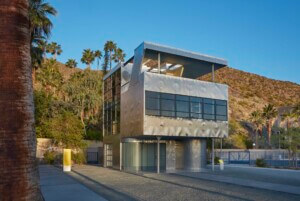California needs 3.5 million housing units. That’s more housing units than currently exist in most states. This shortage—California ranks 49th in housing units per capita, ahead of only Utah—developed slowly but has metastasized into a true crisis, with housing costs rising to untenable levels for all but the most well-off Californians.
In considering how and where to add a volume equivalent to all of Virginia, a key question is, what state—or, rather, what city—will those new units look like? Will they look like the tract homes of Phoenix? The row houses of Philadelphia? The high-rise apartments of New York City? The triple-deckers of Boston? The genteel mansions of Richmond?
Or, perhaps worst of all, the mid-rises of Hollywood?
The answers depend in large part on where new housing gets built. A recent bill in the California legislature almost provided the answer—almost.
Senate Bill 50, sponsored by San Francisco–based State Senator Scott Wiener, would have mandated increased housing densities around major public transit lines and “jobs rich” areas throughout the state by requiring cities to permit multifamily buildings of up to five stories by right. Wiener contended that California needs more housing and that the best locations are those that enable residents to minimize commuting by personal automobiles. A relatively late amendment would have eliminated single-family zoning, permitting homeowners to build up to four units on any single-family lot, and limited the high-density provisions to counties of over 600,000 residents.
California has always maintained a tense relationship with density, often failing to plan for it while suffering its ill effects all the same. SB 50 could be the catalyst to help the state abandon its suburban fetishes once and for all.
An updated version of a bill that Wiener sponsored last year, SB 50 nearly made it out of the State Senate until Appropriations Committee Chair Anthony Portantino scuttled it with a procedural tactic, refusing to bring it to a vote in committee. The move put an abrupt end to what had arguably been the most heated debates over land-use legislation in state history.
SB 50, like many other recent controversies related to development and housing in California, did not inspire neat loyalties. While its core support came from the increasingly influential YIMBY movements and core opposition came from homeowners, the politics were messy at best.
Conservatives could love its relaxation of regulations but hate its emphasis on dense urbanism. Liberals were more intensely fractured. SB 50 appealed to values of inclusion and of progressivism, be they socioeconomic or aesthetic. For some, the bill served the cause of equity simply by potentially creating more housing.
Other liberals saw it differently. Advocates of social justice feared SB 50 would empower capitalist developers while displacing and disenfranchising vulnerable populations through eviction and demolition. Older liberal activists, especially in suburban areas, put their economic interests first, recoiling from the prospect that increased housing supply might depress their property values. Many of them protested SB 50’s potential to interfere with “neighborhood character.” (Wiener’s antagonist Portantino represents La Cañada Flintridge, a comfortable suburb north of downtown Los Angeles.)
Institutionally, the League of California Cities and many city councils statewide condemned SB 50 for trampling on “local control,” asserting that land use decisions have always belonged to municipalities and municipalities alone. Many mayors, however, including those of Los Angeles, Oakland, San Francisco, and San Jose, praised SB 50 for giving cities a new opportunity to ease their housing crisis—and to do so equitably statewide, forcing housing-phobic cities to approve their fair share of housing rather than ignore demand and dodge their obligations in the name of municipal sovereignty. By some accounts, a full 97 percent of California cities failed to meet their state-mandated housing goals in 2018.
The California chapter of the American Planning Association controversially opposed SB 50, citing concerns about technical aspects of the bill’s language, even though many of its more progressive members favored it. Chapters of the American Institute of Architects did not take a position on it.
Design rarely factored into these discussions explicitly, but its influence cannot be overlooked.
Fears about changes to “neighborhood character” often accompany prejudices about “undesirable” racial or socioeconomic groups. They also refer to lousy design. Many homeowners recoiled against SB 50 out of fear that modest cottages might be overshadowed by a new triplex next door or crowded by the addition of an accessory dwelling unit.
Urban activists took aim at even bigger targets. Opponents of growth in Los Angeles in particular have long railed against what they consider oversized, ugly, and excessively capitalistic apartment buildings. Such enormities often occupy full city blocks and rise five or six stories, with wood framing above one-story concrete bases. They have been the mainstay of Hollywood’s decade-long growth spurt and have arisen in many other moderately dense neighborhoods around the state.
Revulsion is, often, completely justified.
Large but underwhelming, and expensive but unrefined, such developments have poor detailing, clunky dimensions, and, often, antagonistic relationships with the street. They have neither humor nor grace nor character, and they succeed at one thing and one thing only: housing many people. Typically, those people are well off—or at least are pretending to be. While California’s housing crisis has many causes, it’s not unreasonable to say that lousy design is one of them, and it’s not unreasonable for opponents of SB 50 to make apocalyptic predictions about aesthetics.
This is the backdrop against which architects should contemplate the revival of SB 50. Wiener has pledged to bring it back next year, and the appetite for major housing legislation remains fierce—before long, some version of SB 50 will pass, and the opportunities for architects and architecture will be profound. The quality of design that follows the passage of the next version of SB 50 will, without exaggeration, determine the look, feel, and function of California cities for at least the next generation. Many opponents of SB 50 criticize it as a “giveaway” to capitalist developers. If architects are to support the next version of SB 50, they should want to be seen as stewards, not opportunists.
Upzoning around transit stops will create entirely new transit-oriented neighborhoods. Places that currently consist of park-and-ride lots and single-family homes will rise to five and six stories, with less parking than most zoning codes currently mandate. That’s like taking a cookie cutter to San Francisco’s Mission District or Los Angeles’s Koreatown and depositing the result in bedroom communities and office parks. Of course, California has hundreds of major transit stops and jobs centers (over 200 light- and heavy-rail stations alone), and the whole point of SB 50 is to distribute development statewide so that neighborhoods grow gradually. Even so, some places will be transformed sooner rather than later.
In a state where many residents are mortally afraid of density, the choices that architects make will determine whether the new urban California is a dream or a nightmare—they can stumble into the latest versions of capitalist postmodern, or they can reflect on everything we have learned about the benefits of density. Designs have to be thoughtful, attractive, and socially conscious. They have to celebrate density, enhance the public realm, and give California cities a sense of style and character that they have lacked for decades. (Likewise, cities’ design guidelines and review boards will have to get savvier.)
If SB 50’s single-family home provision survives (which seems unlikely), it will create a bonanza for residential architects. They will get to re-learn the art of the duplex, triplex, and quadplex—typologies that used to be common in California but have been all but extinct since the Truman administration. But new homes must not realize neighbors’ worst nightmares. They must not loom over their predecessors. They must not be large for largeness’s sake. In short, they must treat neighbors as clients.
Whatever lawmakers intend for SB 50, the public will render its final judgment according to how architects seize the moment. Whether they like it or not, architects bear the final responsibility to fulfill the public trust.
Of course, the real beauty of SB 50—if it comes to pass and if it works as intended—will be invisible. That will be the opportunity to craft affordable and humane housing for hundreds of thousands Californians.











